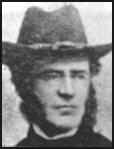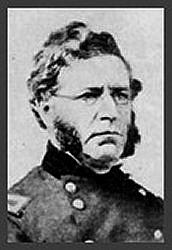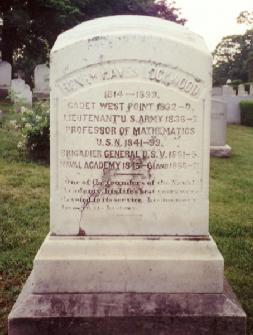

He graduated from West point in 1836 and immediately became involved in the Seminole War. He resigned from the U.S. Army in 1837 and then moved back to Delaware and became a farmer in the Dover, Delaware area. " Henry Hayes Lockwood " married " Anna Rogers Booth " in ca. 1848. She was born the daughter of James Booth, Jr. and Hannah Rogers Booth on February 12, 1820 in Delaware. " Anna " was the grand-daughter of Delaware's 12th Governor " Daniel Rogers ". They had " 8 " known children together: Eliza, James, Anna, Caroline, Julia, Mary, Virginia, and Henry Lockwood. In 1845, with the creation of the U.S. Naval Academy in Annapolis, Maryland, he was contacted by the U.S. Navy to become a professor of mathematics at the Academy. " Lockwood " accepted the position and moved to Annapolis. In May of 1861, with the outbreak of the Civil War, " Gov. William Burton " of Delaware appointed " Lockwood " as the Colonel of the newly organized 1st Delaware Infantry. The appointment only lasted three months when the tour of duty that the Delaware soldiers had signed up for expired. In August of 1861 he was appointed by the U.S. Congress as a " Brigadier General " of Volunteers, a position he held until the end of the Civil War. His first command was to establish a " Military Camp " at " Point Lookout, Maryland " to insure it stayed under the control of the Union. " Lockwood " was successful in that effort. In June of 1863 he was appointed to command the 2nd Brigade of the 1st Division of the XII Corp under " Maj. Gen. Henry Warner Slocum ". This brigade became composed of the 1st Maryland, Potomac Home brigade under the command of Col. William P. Maulsby ..... the 1st Maryland, Eastern Shore Infantry Regiment under the command of Col. James Wallace and the 150th New York Regiment under the command of Col. John H. Ketcham.
At Gettysburg, the Twelfth Corps distinguished itself by its gallant defence of " Culp's Hill ". At one time during the battle, the corps having been ordered to reenforce a distant part of the line, " Brig. Gen. George Sears Greene's " Brigade, of Geary's Division, was left behind to hold this important point. While occupying this position on Culp's Hill, with no other troops in support, Greene was attacked by confederate " Maj. Gen. Edward Johnson's Division ", but the attack was successfully repulsed. The details of this particular action form an interesting chapter in the history of the war. Still, some of Johnson's troops effected, without opposition, a lodgment in the vacated breastworks of the Twelfth Corps, and upon the return of those troops a desperate battle ensued to drive the Confederates out. After a long, hard fight the corps succeeded in re-occupying its works. " Brig. Gen. Lockwood's " brigade was in the action. On no part of the field did the Confederate dead lie thicker than in front of the Twelfth Corps position. Johnson's Division, containing 22 regiments, lost in this particular action, 229 killed, 1,269 wounded, and 375 missing; total, 1,873. To this must be added whatever loss occurred in Smith's, Daniel's, and O'Neil's brigade,-- containing 14 regiments,-- which were sent to Johnson's support. The Twelfth Corps, containing 28 regiments, lost 204 killed, 810 wounded, and 67 missing; total, 1,081. General Slocum was in command of the right wing at Gettysburg, which left General A. S. Williams, of the First Division, in command of the corps; General Thos. H. Ruger of the Third Brigade, First Division, took Williams' place as commander of the "Red Star" Division; General Geary commanded the "White Star," or Second Division. After the Battle of Gettysburg " Lockwood's " brigade along with the XII corp were dispatched to Pursue General Robert E. Lee's army, without much success, which they did until July 24th, 1863. " Lockwood " was shortly afterwards appointed as garrison commander at Harper's Ferry and soon was reappointed as commander of the Middle Dept. at Balitmore, Maryland. From his duty at Baltimore " Lockwood " was appointed to command the 2nd Division of the V Army Corp under Maj.-Gen. Gouverneur K. Warren and the corp was directed toward what was to become known as the " Battle of Cold Harbor " which took place from May 21 - June 3, 1864. " Lockwood's " Division, after becoming lost, ended up not participating in this battle ..... Soon after Cold Harbor " Lockwood " performed departmental duties in Maryland and then led troops against Early's Washington raid. After the war " Lockwood " once again became a professor of Mathmatics at the U.S. Naval Academy in Annapolis, Maryland. Later he also served at the Naval Observatory in Washington, D.C. from which he retired in 1876. " Henry Hayes Lockwood " lived the remainder of his life in Washington where he died on December 7, 1899. He was interred in the United States Naval Academy Cemetery in Annapolis, Maryland. " Henry Hayes Lockwood's " Burial Site : 




Email any questions or comments to:
|
 " Henry Hayes Lockwood " was born on August 17, 1814 somewhere in Kent County, Delaware. It is believed it was in the immediate Dover area.
" Henry Hayes Lockwood " was born on August 17, 1814 somewhere in Kent County, Delaware. It is believed it was in the immediate Dover area.


